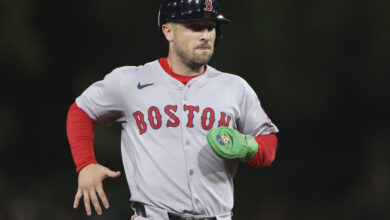
Let’s Consult Warning Label on Potential Cubs Target Alex Cobb
It’s dangerous and downright ignorant to assume baseball players don’t change as the season progresses. In many cases, a player’s full-season stat line is nothing but a messy, heterogeneous sample that clouds signs of actual talent and improvement.
Just look at Kyle Schwarber, who started the season batting under .200 only to record an impressive .378 wOBA from July to October. Just as Schwarber improved measurably from one half to the next, potential Cubs free agent target Alex Cobb posted much better numbers after the All-Star break.
But should we trust Cobb’s second-half stats? Some of the numbers suggest we should be hesitant.
The 30-year-old righty took the mound to start the 2017 season with hopes of completing his first full campaign since 2014. While he managed to accomplish that feat, Cobb had to re-learn how to pitch in the process, as Travis Sawchik of FanGraphs chronicled quite well.
Cobb wasn’t able to rely on his splitter, a pitch so nasty and effective that FanGraphs dubbed it “The Thing” this past season after recovering from surgery that cost him nearly all of 2016. He used to throw the splitter nearly once every three pitches, but halved its usage in 2017 because it wasn’t working as well.
“If I had that answer, it would be here,” Cobb responded when asked about the splitter’s decreased usage and efficacy. “But I do have ideas. Going into Tommy John surgery, you hear that the overall feel of pitches comes back slowly, and the changeup is usually the last one to come back.”
All of a sudden, the former Cy Young candidate had to get batters out without the very pitch that had made his career. He decided to stop throwing splitters, perhaps because he grew tired of trying to find that feel for the pitch, opting instead for the curveball.
After posting a 4.46 FIP up until the All-Star break, Cobb’s increased curve usage yielded an impressive 3.52 FIP in the second half.
While that offers reason for hope, I’m not sure Cobb’s second-half FIP indicates that the former ace is back to his old self. In reality, the two halves might not have been as disparate as those numbers above suggest. For instance, the righty’s May and June Statcast FIPs (scFIPs) were both under 3.60, but ballooned just prior to the the break July.
As a result, his two successful months were dramatically camouflaged. After the All-Star Break, however, Cobb put up his best month scFIP of 2.87, but regressed in September with an underwhelming 4.61 scFIP.
The reason Cobb’s FIP was better in the second half might’ve been due to better sequencing, quality defense, randomness, fewer innings, and luck. Specifically, his 3.23 FIP in September didn’t match the 4.61 scFIP. Those Statcast outcomes tell us Cobb’s batted-ball profile theoretically should’ve resulted in five percent more runs than an average pitcher.
In other words, Cobb didn’t really pitch like a 3.23 FIP pitcher in September and probably didn’t quite “earn” that 3.52 FIP in the second half.
| Month | IP | FIP | scFIP | ERA |
| Apr-17 | 29 | 4.55 | 4.86 | 4.66 |
| May-17 | 39.7 | 3.77 | 3.21 | 2.95 |
| Jun-17 | 32.7 | 3.38 | 3.58 | 3.86 |
| Jul-17 | 39.7 | 5.36 | 5.38 | 4.31 |
| Aug-17 | 16.3 | 3.02 | 2.87 | 2.20 |
| Sep-17 | 22 | 3.23 | 4.61 | 3.27 |
Cobb’s name being mentioned in connection to the Cubs is inevitable. He was involved in trade rumors prior to 2017 and now you’ve got former Rays pitching coach Jim Hickey serving in that same role for the Cubs. On the surface, it seems like a really good fit.
But I’m slightly suspicious of Cobb because of his injury history and the disappearance of his splitter. Granted, he learned to pitch around that loss by throwing more curves, which led to that 3.52 FIP in the second half. There’s also the matter of the splitter possibly returning, as Cobb himself noted.
I’m just not confident that the numbers are accurately reflective of his true talent level, and I’m honestly not sure what to expect from the former Rays pitcher in 2018 as a result.



